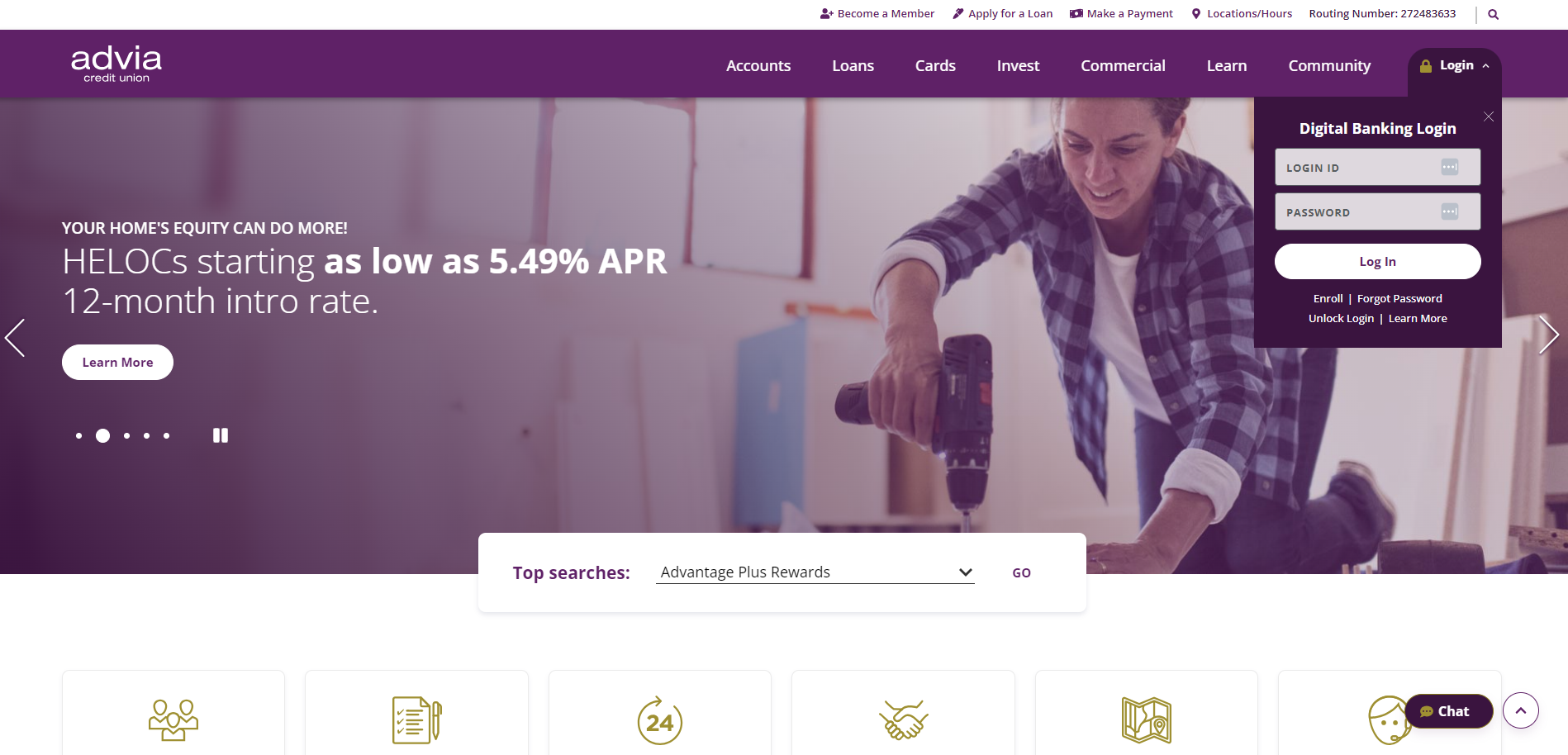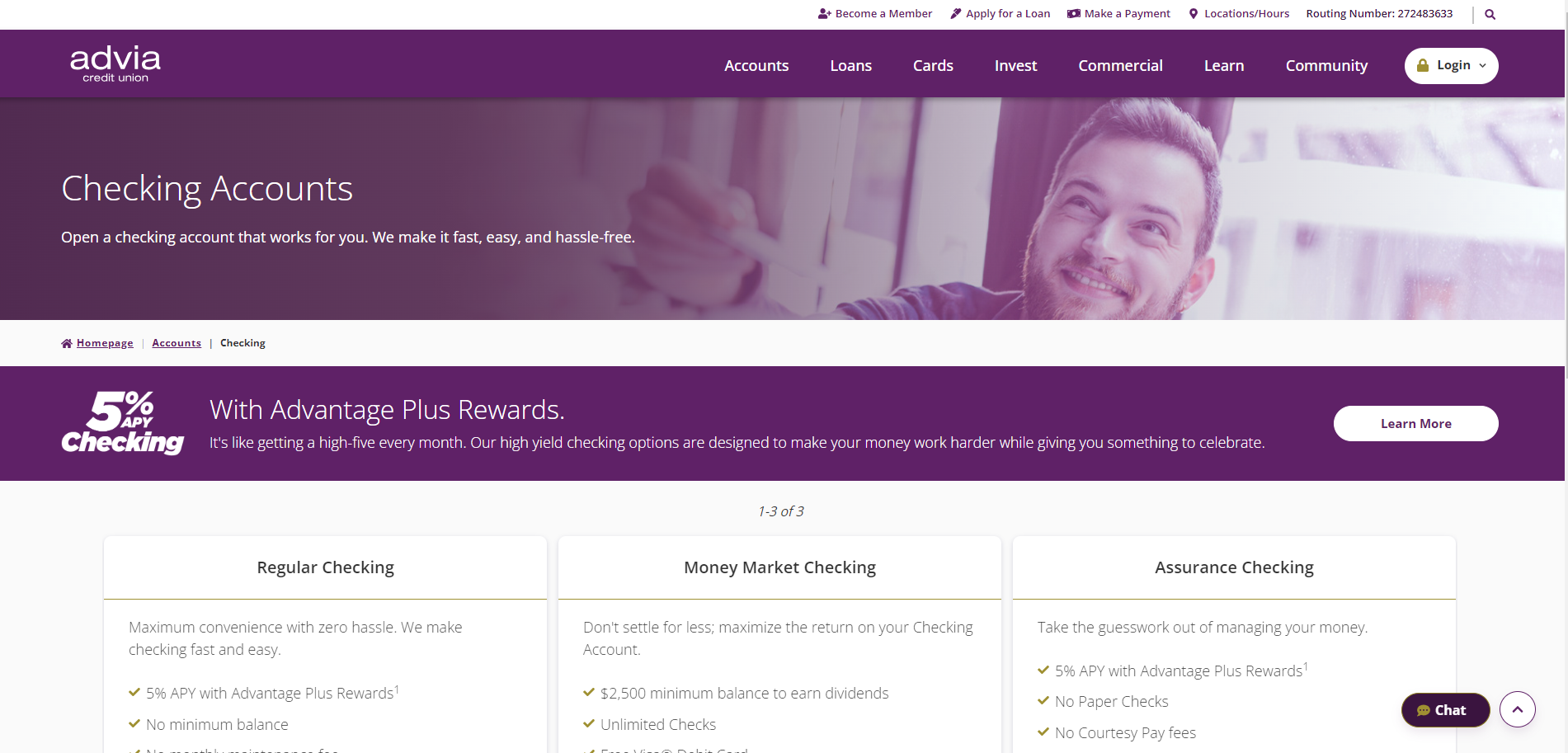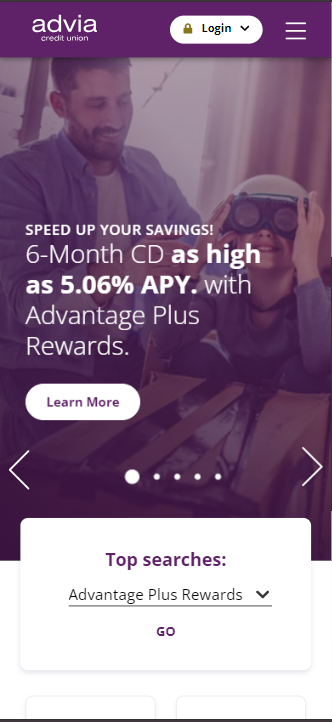ADVIA CREDIT UNION
Services we provide:
- Discovery
- Digital Strategy
- Content Analysis
- Custom Integrations
- UX/UI Design
- Website Development
- Hosting
- Support
About Advia Credit Union
Advia Credit Union has a mission to provide financial advantages to its members by providing advice, advocating for members, and offering advantages other financial institutions don’t. This is accomplished through innovative financial solutions and a new, scalable website. For this new site, Advia sought to proactively provide the quickest and easiest digital solution for members to get the best user experience. Advia is not like other financial institutions; this is illustrated in Advia’s commitment to serving the ever-changing financial needs of its members. One of its core values is to drive progress by engaging in a spirit of innovation and developing new digital service tools for its members. This led to an innovative website redesign to give members easy access to information digitally.
The Challenge
The old website was not intuitive, and the overall digital experience lacked. The lending areas of the old site for both mortgages and auto loans were not producing results. With increased in mobile traffic, the site needed an improved mobile user experience. A major challenge facing Advia’s business team was the organization and content hierarchy of the old site. The content was repetitive and text-heavy, and members were confused about where to find the information they sought. Other obstacles included Advia’s team being unable to easily update the content and structure of the pages on the old website.
Goals for the New Site:
- Improved navigation layout
- Measurable enhancements
- Increase time spent on the website
- Meets brand standards with redesign
- Increase overall visitors engagement
- Increase content management efficiency
Advia wanted to create a “one-stop” resource center to educate members on digital banking—including forms, links, documents, and video tutorials. Two goals for the new Advia Credit Union website were simplifying content and allowing self-service for members. Advia did not want to reinvent the wheel in terms of UI but wanted to deliver a better digital experience to its members and potential new members. The new website provides a clean and clear navigation experience to eliminate clutter and confusion.
The Right Platform
SilverTech reviewed several CMS/DX platforms with Advia. Progress Sitefinity was the chosen platform, giving Advia a fully optimized digital experience. Using the page templates on the Sitefinity platform allows Advia to accomplish the goals for the new site by enhancing the design and layout of the website with ease. The new website improves the user experience with the use of properly placed navigation buttons and call to actions (CTAs) clearly directing users through the content on the page to the sub-pages. Advia’s site has an engaging navigation and advanced filter functionality allowing users to get to the content they are looking for with ease. Additionally, the Advia content team can seamlessly update and create pages within the Sitefinity CMS, keeping the website current and relevant.
RESULTS
Launching Your Website Isn’t the End. It’s Just the Beginning.
5/7/25
Consider it a Growth Opportunity — Not a Checkmark.
Launching a new website is a major milestone. But rather than sighing a sense of relief and focusing your attention to other projects, you've got to find your second-wind post launch to make sure your site is realizing its potential. Your website should be more of a journey than a destination.
Once your site goes live, the focus needs to shift from delivery to performance. The most successful digital teams treat launch day as the point at which the real work begins: optimizing for search visibility, validating assumptions through user testing, driving targeted traffic, and establishing continuous performance measurement practices.
Below are the core areas marketers should invest in immediately post-launch to ensure the site performs as a high-value business asset.
1. SEO Optimization: Structure, Indexing, and Content Relevance
A technically sound site is critical—but so is continuous SEO refinement. Post-launch, it’s essential to:
• Audit the crawlability and indexing status using Google Search Console
• Revalidate 301 redirects and ensure legacy URL equity is preserved
• Monitor shifts in rankings and click-through rates across priority keywords
• Identify content gaps or mismatches based on real-time search behavior
• Optimize internal linking structure and metadata for new user flows
Failing to maintain SEO momentum after launch can result in significant traffic and visibility losses. Sustained optimization ensures your site earns and retains organic visibility as search algorithms. Learn about evolving SEO strategies here.
2. User Testing and Behavior Analytics
Pre-launch usability testing provides insight, but live usage data is more valuable.
Immediately post-launch, teams should deploy tools like Hotjar, Microsoft Clarity, or FullStory to capture:
• Scroll depth and interaction heatmaps
• Click patterns and conversion drop-offs
• Session recordings to identify friction points
Use this behavioral data to validate navigation structures, refine CTA placement, and adjust form lengths or page layouts. Small user experience improvements can have a measurable impact on conversion performance. We've seen lifts of double digits in conversion from post-launch user testing. Learn more about the user testing we did for F&M Bank and how it really boosted web performance.
3. Traffic Generation: Digital Marketing, Paid Media, and Social
Without sustained traffic, your new site won't have a chance to convert.
Post-launch, marketing teams should align campaign calendars to actively encourage traffic to visit the website through:
• Paid Search & Display Advertising – Drive qualified traffic to high-conversion landing pages.
• Social Media Advertising – Retarget site visitors and promote newly published content.
• Email Marketing – Reintroduce audiences to updated navigation paths or new service pages.
• Content Syndication – Extend your reach by distributing content via trusted industry channels.
Integrate UTM tagging into all efforts and set up goal funnels to ensure you’re tracking engagement and conversions accurately.
4. Conversion Tracking and Reporting Infrastructure
Launching a site without well-defined KPIs and conversion tracking is a missed opportunity. At a minimum, you should:
• Configure Google Analytics 4 (GA4) or another analytics platform with goals/events
• Set up enhanced ecommerce or funnel tracking as applicable
• Integrate with your CRM or marketing automation platform to capture lead source and campaign attribution
• Build custom dashboards (e.g., in Looker Studio, Power BI, or Tableau) to monitor user behavior, traffic sources, and conversion rates
Tracking the right data allows you to demonstrate ROI to stakeholders, optimize future campaigns, and make informed decisions about site enhancements.
5. Continuous Content Development and SEO Expansion
Post-launch SEO doesn’t stop at technical health. It extends into content velocity.
Establish an editorial calendar aligned with high-volume, high-intent keyword clusters uncovered through tools like SEMrush or Ahrefs. Leverage topic clusters, internal linking strategies, and structured data to expand your footprint across the funnel—from lead to loyal.
Additionally, ensure your site is eligible for rich results (e.g., FAQs, reviews, breadcrumbs) by implementing structured content and the appropriate schema markup.
Final Takeaway
A website is not a one-time project. It’s a digital platform that requires constant optimization, promotion, and measurement to fulfill its strategic potential.
By investing in post-launch SEO, behavioral analysis, targeted traffic acquisition, and performance tracking, you can transform your website into a dynamic growth engine.
If your organization needs support aligning your site to business outcomes post-launch, we can help.



